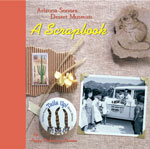
Extended Entries to the ASDM Scrapbook
Skunk Visitors
by Dr. Roger Carpenter
I was a teenager working at the Desert Museum soon after its establishment and from those days recall three "skunk" incidents.
The earliest was when Lew Walker first had his wildlife blind going, in the shallow wash east of the house where he and Melanie lived. I spent many nights there in the summers taking photographs of the deer, javelinas, ring-tailed cats, coyotes, and skunks that came in to the meat and water. One night, when the barrage of four large flash bulbs went off to photograph a skunk, the animal panicked, and ran around the corner of the blind . . . right into the blind, which was occupied then by four people. All froze while the skunk wandered over our feet, and then out the door. But it never sprayed!
Somewhat later, Lew had a series of four small walk-in cages built in the patio of that house. He kept owls and various other animals in these cages, including several descented skunks. One of these escaped. Several evenings later, Lew was down near the stables, and saw a skunk wandering about in the dusk. He approached it; it did not flee, nor make any threats. He picked it up by its tail, and strode (as only Lew could stride) back toward the house and cages. Melanie was out in front as he approached. When he saw her he held up the skunk and yelled, "Hey, Melanie-I just caught my skunk!" At the sound of his voice the skunk-a local wild one-let loose from its scent glands and sprayed Lew right in the face.
There was major remodeling being done in the old kitchen in the main building. This was a long room, with a counter along one wall, with continuous cupboards beneath the counter top. At one end of the room was a deep freeze, where the week's meat was stored for the large carnivores, and where, each evening, some packages were put out to thaw overnight for preparation of food for the next night's feeding to the mountain lion, coyotes, skunks, etc. The remodeling, which went very slowly, began with cutting a hole through an exterior wall for a new door. As a result, for many weeks there was this open passageway between the external world and the thawing meat each night.
The wild skunks soon discovered this, and came in at night, clawed open the packages and ate what they could of the frosty meat. But before long, they took up residence in the cupboards beneath the counter top, entering through the kick spaces beneath the cabinet door. Very quickly, each cupboard had its resident skunk, which remained there throughout the day, despite the fact that staff were working in the area, and preparing the afternoon meals for animals on the counters above. If we opened the cabinet doors, the skunks slowly awoke, with bleary eyes, looked at the intruder, and then went back to sleep. Most were hooded or striped, but one was an adult spotted skunk, who slept within its cabinet in a corrugated cardboard box. At night these skunks emerged, climbed onto the counter, and ripped open the thawing meat and had their fill. There was some squabbling among them, but never any spraying of each other, of the kitchen, or of any of us who opened the cabinet doors.










